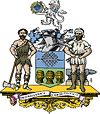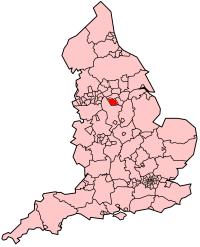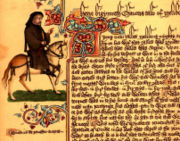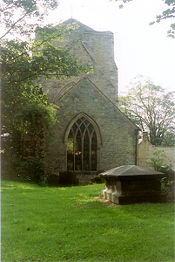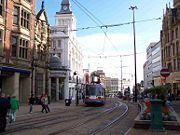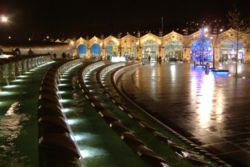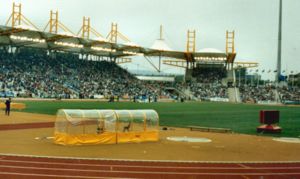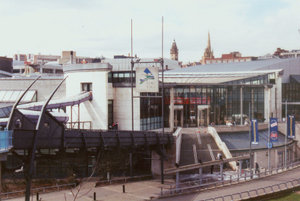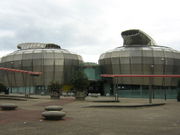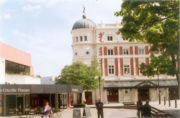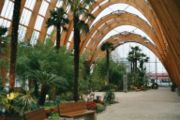Sheffield
2008/9 Schools Wikipedia Selection. Related subjects: British Cities; Great Britain
| City of Sheffield | |||
|
|||
| Nickname: "The Steel City" | |||
| Motto: "Deo Adjuvante Labor Proficit" "With God's help our labour is successful" | |||
| Sheffield shown within England | |||
| Coordinates: | |||
|---|---|---|---|
| Sovereign state | United Kingdom | ||
| Constituent country | England | ||
| Region | Yorkshire and the Humber | ||
| Ceremonial county | South Yorkshire | ||
| Admin HQ | Sheffield City Centre | ||
| Founded | ~8th century | ||
| Town charter | 10 August 1297 | ||
| City status | 1893 | ||
| Government | |||
| - Type | Metropolitan borough, City | ||
| - Governing body | Sheffield City Council | ||
| - Lord Mayor | Arthur Dunworth | ||
| - MPs: | Clive Betts (L) David Blunkett (L) Richard Caborn (L) Nick Clegg (LD) Meg Munn (L) Angela Smith (L) |
||
| Area | |||
| - Borough & City | 142.1 sq mi (367.94 km²) | ||
| Population (2006 est.) | |||
| - Borough & City | 525,800 ( Ranked 3rd) | ||
| - Density | 3,701.1/sq mi (1,429/km²) | ||
| - Urban | 640,720 ( Sheffield urban area) |
||
| - Urban Density | 10,228.4/sq mi (3,949.2/km²) | ||
| - City Region | 1,819,500 | ||
| - County | 1,292,900 | ||
| Time zone | Greenwich Mean Time ( UTC+0) | ||
| Postcode | S | ||
| Area code(s) | 0114 | ||
| ISO 3166-2 | GB-SHF | ||
| ONS code | 00CG | ||
| OS grid reference | SK352878 | ||
| NUTS 3 | UKE32 | ||
| Demonym | Sheffielders | ||
| Website: www.sheffield.gov.uk | |||
Sheffield ( pronunciation ) is a city and metropolitan borough in South Yorkshire, England. It is so named because of its origins in a field on the River Sheaf that runs through the city.
The city has grown from its largely industrial roots to encompass a wide economic base. The population of the City of Sheffield is estimated at 525,800 people (2006), and it is one of the eight largest English cities outside London, which form the English Core Cities Group. The wider Sheffield Urban Area, which extends beyond the city proper, has a population of 640,720.
Sheffield obtained world-wide recognition during the 19th century for its production of steel. Many innovations in the industry were developed locally, including crucible and stainless steel. This fuelled an almost tenfold increase in the population during the Industrial Revolution. It gained its city charter in 1893 and became officially titled the City of Sheffield. International competition caused a decline in local industry during the 1970s and 1980s, and at the same time the nearby national coal industry collapsed, affecting Sheffield's population.
History
The area that is now the City of Sheffield has been occupied since at least the last ice age, but the settlements that grew to form Sheffield date from the second half of the 1st millennium, and are of Anglo-Saxon and Danish origin. In Anglo-Saxon times the Sheffield area straddled the border between the kingdoms of Mercia and Northumbria. The Anglo-Saxon Chronicle reports that King Eanred of Northumbria submitted to King Egbert of Wessex at the hamlet of Dore (now a suburb of Sheffield) in 829. This event made Egbert the first Saxon to claim to be king of all of England. After the Norman conquest, Sheffield Castle was built to control the local settlements, and a small town developed that is the nucleus of the modern city.
By 1296 a market had been established at what is now known as Castle Square, and Sheffield subsequently grew into a small market town. In the 14th century Sheffield was already noted for the production of knives, as mentioned in Geoffrey Chaucer's The Canterbury Tales, and by 1600 it had become the main centre of cutlery production in England, overseen by The Company of Cutlers in Hallamshire. From 1570 to 1584 Mary, Queen of Scots was held as a prisoner in Sheffield Castle and Sheffield Manor.
In the 1740s a form of the crucible steel process was discovered that allowed the manufacture of a better quality of steel than had previously been available. At about the same time a technique for fusing a thin sheet of silver onto a copper ingot to produce silver plating was invented and became widely known as Sheffield plate. These innovations spurred the growth of Sheffield as an industrial town. However, the loss of some important export markets led to a recession in the late 18th and early 19th centuries. The resulting poor conditions culminated in a cholera epidemic that killed 402 people in 1832. The Industrial Revolution saw a resurgence of Sheffield through the 19th century. As a result of its growing population, the town was incorporated as a borough in 1842 and granted a city charter in 1893. The influx of people also led to demand for better water supplies, and a number of new reservoirs were constructed on the outskirts of the town. The collapse of the dam wall of one of these reservoirs in 1864 resulted in the Great Sheffield Flood, which killed 270 people and devastated large parts of the town. The growing population also led to the construction of a large number of back-to-back slums, which, along with severe pollution from the factories, inspired George Orwell, writing in 1937, to declare, "Sheffield, I suppose, could justly claim to be called the ugliest town in the Old World".
A recession in the 1930s was halted by only the increasing international tension as World War II loomed. The steel factories of Sheffield were set to work making weapons and ammunition for the war. As a result, once war was declared, the city became a target for bombing raids, the heaviest of which occurred over the nights of 12 December and 15 December 1940 (now known as the Sheffield Blitz). More than 660 lives were lost and numerous buildings were destroyed.
In the 1950s and 1960s, many of the slums were demolished and replaced with housing schemes such as the Park Hill flats. Large parts of the city centre were also cleared to make way for a new system of roads. Increased automation and competition from abroad resulted in the closure of many steel mills. The 1980s saw the worst of this run-down of Sheffield's industries (along with those of many other areas in the UK). The 1984/5 miners' strike affected the coal mining areas to the east and north east of Sheffield, though it is unlikely to have had a major impact upon Sheffield's economy. The building of the Meadowhall shopping centre on the site of a former steelworks in 1990 was a mixed blessing, creating much needed jobs but speeding the decline of the city centre. Attempts to regenerate the city were kick-started when the city hosted the 1991 World Student Games, WSG, which saw the construction of new sporting facilities such as the Sheffield Arena, Don Valley Stadium and the Ponds Forge complex.
The city is now changing rapidly as new projects aim to regenerate some of the more run-down parts of the city. One such project, the Heart of the City Project, has seen a number of public works in the city centre: the Peace Gardens were renovated in 1998, the Millennium Galleries opened in April 2001, the Winter Gardens were opened on 22 May 2003, and a public space to link these two areas, the Millennium Square, was opened in May 2006. Further developments included the remodelling of Sheaf Square in front of the recently refurbished railway station. The new square contains The Cutting Edge a sculpture designed by Si Applied Ltd made of Sheffield steel.
Governance
The city currently returns six Members of Parliament to the House of Commons, but this will be reduced to five at the next election as one constituency, Hillsborough, will be abolished and merged with three other constituencies.
Sheffield is governed by the elected Sheffield City Council. For most of the council's history it has been controlled by the Labour Party, and has historically been noted for its leftist sympathies; during the 1980s administration under David Blunkett, the area earned the sarcastic and rather derogatory appellation " People's Republic of South Yorkshire" from the British Right. However, the Liberal Democrats controlled the Council briefly at the turn of the 21st century. There are 84 councillors; the current council leader is Jan Wilson. The city also has a Lord Mayor. In the past the Office of Mayor had considerable authority, and carried with it executive powers over the finances and affairs of the city council. Today it is simply a ceremonial role. The current (2007/08) Lord Mayor is Arthur Dunworth. During the English Local Election 2007 the Labour Party lost the council to NOC, with the Liberal Democrats gaining enough seats to make it a joint control council, one of 80 that year. The tacit support of the Green party ensured Labour remains in control.
The majority of council-owned facilities are now operated by independent charitable trusts. Sheffield International Venues runs many of the cities sporting and leisure facilities, including Sheffield Arena and Don Valley Stadium. Sheffield Galleries and Museums Trust and the Sheffield Industrial Museums Trust take care of galleries and museums owned by the council. These include the Millennium Galleries, Lyceum Theatre and the Crucible Theatre.
International links
Sheffield is formally twinned with Anshan in China, Bochum in Germany, Donetsk in Ukraine, and Esteli in Nicaragua. There are more informal links with Kawasaki in Japan, Kitwe in Zambia, and Pittsburgh in the United States. Sheffield has also had close links with Poland, since Polish ex-servicemen who had fought alongside British forces during the Second World War settled in the city. As a result a Polish consulate was opened in the City in 1997 (now closed), the first new Polish consulate to open in the UK for over 60 years.
Geography
Sheffield is located at . It lies directly beside Rotherham, from which it is separated by the M1 motorway. Although Barnsley Metropolitan Borough also borders Sheffield to the north, the town itself is a few miles further away. The southern and western borders of the city are shared with Derbyshire; in the first half of the 20th century Sheffield extended its borders south into Derbyshire, annexing a number of villages, including Totley, Dore and the area now known as Mosborough Townships. Directly to the west of the city is the Peak District National Park and the Pennine hill range.
Sheffield is a geographically diverse city. The city nestles in a natural amphitheatre created by several hills and the confluence of five rivers: Don, Sheaf, Rivelin, Loxley and Porter. As such, much of the city is built on hillsides with views into the city centre or out to the countryside. The city's lowest point is just 33 feet (10 m) above sea level, while some parts of the city are at over 1,640 feet (500 m). However, 89% of the housing in the city is between 330 and 660 feet (100-200 m) above sea level.
With an estimated total of over two million trees, Sheffield has more trees per person than any other city in Europe. It has over 170 woodlands (covering 10.91 sq mi/28.3 km² ), 78 public parks (covering 7.07 sq mi/18.3 km²) and 10 public gardens. Added to the 52.0 square miles (134.7 km²) of national park and 4.20 square miles (10.9 km²) of water this means that 61% of the city is greenspace.
Sheffield also has a very wide variety of habitat, comparing favourably with any city in the United Kingdom: urban, parkland and woodland, agricultural and arable land, moors, meadows and freshwater-based habitats. Large parts of the city are designated as sites of special scientific interest including several urban areas.
The present city boundaries were set in 1974 (with slight modification in 1994), when the former county borough of Sheffield merged with Stocksbridge Urban District and two parishes from the Wortley Rural District. This area includes a significant part of the countryside surrounding the main urban region. Roughly a third of Sheffield lies in the Peak District National Park (no other English city includes parts of a national park within its boundary), and Sheffield often boasts of being Europe's greenest city, a claim that was reinforced when it won the 2005 Entente Florale competition. This was helped by the fact that Sheffield contains over 150 woodland spaces and 50 public parks.
Subdivisions
| Sheffield Compared | |||
|---|---|---|---|
| UK Census 2001 | Sheffield | South Yorkshire | England |
| Total population | 513,234 | 1,266,338 | 49,138,831 |
| Foreign born | 6.4% | 8.9% | 9.2% |
| White | 91% | 95% | 91% |
| Asian | 4.6% | 2.6% | 4.6% |
| Black | 1.8% | 0.9% | 2.3% |
| Christian | 69% | 75% | 72% |
| Muslim | 4.6% | 2.5% | 3.1% |
| Hindu | 0.3% | 0.2% | 1.1% |
| No religion | 18% | 14% | 15% |
| Over 75 years old | 8.0% | 7.6% | 7.5% |
| Unemployed | 4.2% | 4.1% | 3.3% |
Sheffield is made up of numerous suburbs and neighbourhoods, many of which developed from villages or hamlets that were absorbed into Sheffield as the city grew. These historical areas are largely ignored by the modern administrative and political divisions of the city; instead it is divided into 28 electoral wards, with each ward generally covering 4–6 areas. The electoral wards are grouped into six parliamentary constituencies, although because of a different review cycle, the ward and constituency boundaries are currently not all conterminous. Sheffield is largely unparished, but Bradfield and Ecclesfield have parish councils, and Stocksbridge has a town council.
Demography
People from Sheffield are called Sheffielders. They are also colloquially known to people in the surrounding towns of Barnsley, Doncaster, Rotherham and Chesterfield as "dee-dars" (which derives from the traditional pronunciation of the "th" in the dialectal words "thee" and "thou", which is now extremely rare to hear). Many Yorkshire dialect words and aspects of pronunciation derive from old Norse due to the Viking influence in this region.
At the time of the 2001 UK census, the ethnic composition of Sheffield's population was 91.2% White, 4.6% Asian, 1.8% Black, and 1.6% mixed. Sheffield also has large Polish, Somali, Slovak, Yemeni and Albanian populations. In terms of religion, 68.6% of the population are Christian and 4.6% Muslim. Other religions represent less than 1% each. The number of people without a religion is above the national average at 17.9%, with 7.8% not stating their religion. The largest quinary group is 20- to 24-year-olds (9.4%), mainly because of the large university population (45,000+).
Population change
Below is a table outlining population change of the city since 1801. The total population of Sheffield peaked in 1951 at 577,050, and has since seen a steady decline. Recently the city's population has been growing however and the city has absorbed 12,500 new residents since 2001.
| Year | 1801 | 1851 | 1901 | 1921 | 1941 | 1951 | 1961 | 1971 | 1981 | 1991 | 2001 | ||
|---|---|---|---|---|---|---|---|---|---|---|---|---|---|
| Population | 60,095 | 161,475 | 451,195 | 543,336 | 569,884 | 577,050 | 574,915 | 572,794 | 530,844 | 528,708 | 513,234 | ||
| Source: A Vision of Britain through Time | |||||||||||||
Economy
| Labour Profile | ||
|---|---|---|
| Total employee jobs | 255,700 | |
| Full-time | 168,000 | 65.7% |
| Part-time | 87,700 | 34.3% |
| Manufacturing | 31,800 | 12.4% |
| Construction | 8,500 | 3.3% |
| Services | 214,900 | 84.1% |
| Distribution, hotels & restaurants | 58,800 | 23.0% |
| Transport & communications | 14,200 | 5.5% |
| Finance, IT, other business activities | 51,800 | 20.2% |
| Public admin, education & health | 77,500 | 30.3% |
| Other services | 12,700 | 5.0% |
| Tourism-related | 18,400 | 7.2% |
After many years of decline, the Sheffield economy is going through a strong revival. The 2004 Barclays Bank Financial Planning study revealed that, in 2003, the Sheffield district of Hallam was the highest ranking area outside London for overall wealth, the proportion of people earning over £60,000 a year standing at almost 12%. A survey by Knight Frank revealed that Sheffield was the fastest-growing city outside of London for office and residential space and rents during the second half of 2004. Some £250 million was also invested in the city during 2005. The Sheffield economy is worth £7.4 billion (2003 GVA). This can be seen by the current surge of redevelopments, including the City Lofts Tower and accompanying St. Pauls Place, Velocity Living, and the Moor redevelopment, the forthcoming NRQ and the recently completed Winter Gardens, Peace Gardens, Millennium Galleries, many project under the Sheffield One redevelopment agency.
Sheffield has an international reputation for metallurgy and steel-making. Many innovations in these fields have been made in Sheffield. Benjamin Huntsman discovered the crucible technique in the 1740s at his workshop in Handsworth. This process was made obsolete in 1856 by Henry Bessemer's invention of the Bessemer converter. Thomas Boulsover invented Sheffield Plate (silver-plated copper) in the early 18th century. Stainless steel was invented by Harry Brearley in 1912, and the work of F. B. Pickering and T. Gladman throughout the 1960s, '70s, and '80s was fundamental to the development of modern high-strength low-alloy steels. Further innovations continue, with new advanced manufacturing technologies and techniques being developed on the Advanced Manufacturing Park by Sheffield's universities and other independent research organisations. Organisations currently located on the AMP include; the Advanced Manufacturing Research Centre (AMRC, a research partnership between The Boeing Company and The University of Sheffield), Castings Technology International (Cti) and TWI.
While iron and steel have long been the main industries of Sheffield, coal mining has also been a major industry, particularly in the outlying areas, and the Palace of Westminster in London was built using limestone from quarries in the nearby village of Anston. Other areas of employment include call centres, the City Council, universities and hospitals. Sheffield currently produces more steel per year than at any other time in its history. However, the industry is now less noticeable as it has become highly automated and employs far fewer staff than in the past.
Sheffield is also a major retail centre, and home to many High Street and department stores as well as designer boutiques. The main city centre shopping areas are on The Moor precinct, Fargate, Orchard Square and the Devonshire Quarter. Department stores in Sheffield City centre include John Lewis, Marks and Spencer, Atkinsons, Castle House Co-op, Debenhams and Woolworths . Sheffield's main market is the Castle Market, built above the remains of the castle. Shopping areas outside the city centre include the Meadowhall shopping centre and retail park, Ecclesall Road, London Road, Hillsborough and the Crystal Peaks shopping centre.
Sheffield has a District Energy system which exploits the city's domestic waste, converting it to electricity. It also provides hot water, which is distributed through over 25 miles (40 km) of pipes under the city, via two networks. These networks supply heat and hot water for many buildings throughout the city. These include not only cinemas, hospitals, shops, and offices but also universities ( Sheffield Hallam University and the University of Sheffield), residential properties. Energy generated in a waste plant produces 36MW of thermal energy and up to 6.8MW electrical energy from 115,000 tonnes of waste. It is claimed that for every 100,000MWh of energy supplied by district energy 31,000 tonnes of carbon dioxide is displaced and that for every 100,000MWh of useful energy delivered 154,000MWh of fossil fuel energy is displaced.
In a 2005 survey on spending potential, Meadowhall came 16th (third in out-of-town shopping centres behind Bluewater(7th) and The Trafford Centre(15th)) with £977 million while Sheffield city centre came 18th with £953 million. In a 2004 survey on the top retail destinations, Meadowhall was 20th while Sheffield was 35th.
Transport
There are two main interchanges for all public transport modes ( national and local rail, tram, local buses and coaches) at Meadowhall and in the city centre.
National and international travel
Sheffield is linked into the national motorway network via the M1 and M18 motorways. The M1 skirts the north-east of the city, linking Sheffield with London to the south and Leeds to the north and crosses Tinsley Viaduct near Rotherham; the M18 branches from the M1 close to Sheffield, linking the city with Doncaster, Robin Hood Doncaster Sheffield Airport and the Humber ports. The Sheffield Parkway connects the city centre with the motorways. The A57 and A61 roads are the major trunk roads through Sheffield, linking Sheffield with Manchester, Worksop, Barnsley, and Chesterfield. Sheffield is an important hub in the national network of long-distance buses (coaches), and there are direct services from distant cities such as Plymouth and Edinburgh.
The Midland Main Line railway south from Sheffield links the city to the East Midlands and London: providing direct services to Nottingham, Derby, Leicester, Bedford (the fastest train Sheffield to London is two hours). Also running through Sheffield is the main NE/SW cross-country line which links the East of Scotland and Northeast of England directly with West and South Yorkshire, the West Midlands, and the Southwest: providing direct services to Aberdeen, Edinburgh, Newcastle, Darlington, York, Leeds, Birmingham, Bristol, Taunton, and Exeter. Sheffield also lies on the line linking Liverpool and Manchester with Hull and East Anglia: providing direct services to Liverpool, Manchester, Hull, Lincoln, Ely and Norwich. Sheffield also has good links with its neighbouring towns and cities, Barnsley, Doncaster and Rotherham. The main station for all these services is Sheffield Midland station on the south-eastern edge of the city centre. The station at Meadowhall serves all trains travelling northeast except the fastest. Passenger rail services through Sheffield are provided by East Midlands Trains, Cross Country, TransPennine Express, and Northern Rail.
The closest international airport to Sheffield is Doncaster Sheffield Airport, which is located 18 miles (29 km) from the city centre. The airport opened on April 28, 2005 and is served mainly by budget airlines. It currently handles around one million passengers a year. Sheffield City Airport opened in 1997 but, due in part to its short runway and lack of radar, has been unable to capitalise on the boom in low cost air travel. Manchester Airport, Leeds Bradford International Airport and East Midlands Airport: Nottingham, Leicester, Derby all lie within a one hour's drive of the city. Manchester Airport is connected to Sheffield by a direct train every hour.
Local travel
The A57 and A61 roads are the major trunk roads through Sheffield. These run east-west and north-south, respectively, crossing in the city centre. Other major roads generally radiate spoke-like from the city centre. An inner ring road, mostly constructed in the 1970s and recently (2007) extended to form a complete ring, allows traffic to avoid the city centre, and an outer ring road runs to the east, south-east and north, nearer the edge of the city, but does not serve the western side of Sheffield.
The hilly topography of Sheffield and its former nature as a centre of industry rather than commerce meant that the city did not develop as extensive a suburban and inter-urban railway network as other comparable British cities. However, there are several busy local rail routes running along the city's valleys and beyond, connecting it with other parts of South Yorkshire, West Yorkshire, Nottinghamshire, Lincolnshire and Derbyshire. These local routes include the Penistone Line, the Dearne Valley Line, the Hope Valley Line, and the Hallam Line. As well as the main stations of Sheffield and Meadowhall, there are four suburban stations at Chapeltown, Darnall, Woodhouse and Dore.
The light rail system Sheffield Supertram (Operated by Stagecoach Sheffield), opened in 1994, serves the city. Its network consists of three lines, from Halfway to Malin Bridge, from Meadowhall to Middlewood, and from Meadowhall to Herdings Park, with all three lines running via the city centre.
A sizeable bus infrastructure operates from a main hub at Pond Street bus station. Other bus stations lie at Halfway, Hillsborough and Meadowhall. A flurry of new operators were created after deregulation in 1986, though a series of mergers have reduced the number. First South Yorkshire, part of FirstGroup, became by far the largest bus operator and in recent years implemented a series of fare rises and service cuts which saw bus ridership drop.. Recent developments have seen Stagecoach Sheffield taking over Yorkshire Terrier and expanding their bus services in the city. This has resulted in increased competition, and price drops on certain routes.
Sheffield also offers a free bus service - the FreeBee. This service is operated by TM Travel, and runs every seven minutes between the station and the city centre.
Although hilly, Sheffield is compact and has few major trunk roads running through it. It is on the Trans-Pennine Trail, a National Cycle Network route running from Southport in the north-west to Hornsea in the East Riding, and has a developing Strategic Cycle Network within the city. The Peak District National Park, an area of outstanding natural beauty popular with both on- and off-road cyclists, is so close to Sheffield that part of the park lies within the city boundary, and there are green routes into the park almost from the city centre.
Sport
Sheffield has a long sporting heritage. In 1857 a collective of cricketers formed the world's first-ever official football club, Sheffield F.C., and by 1860 there were 15 football clubs in Sheffield. There are now two local clubs in the Football League and play in the Football League Championship: Sheffield United and Sheffield Wednesday, both of which formed from cricket clubs, and two major non-league sides: Sheffield F.C. and Hallam F.C., which also formed from cricket clubs. These are the two oldest club sides in the world and, in addition, Hallam F.C. still play at the world's oldest football ground near the suburb of Crosspool. Sheffield and Hallam contest what has become known as the Sheffield derby, whilst United and Wednesday contest the Steel City derby.
In April 1989, tragedy struck when 96 Liverpool FC fans died in a crush during their FA Cup semi final at Sheffield Wednesday's Hillsborough Stadium.
Sheffield also has close ties with snooker, due to the fact that the city's Crucible Theatre is the venue for the World Snooker Championships. The English squash open is also held there every year. The International Open Bowls tournament is held in Sheffield at Ponds Forge.
The city also boasts the Sheffield Eagles rugby league, Sheffield Tigers Rugby Union, Sheffield Sharks basketball, Sheffield Steelers ice hockey and Sheffield Tigers Speedway teams. Sheffield is home to 2004 and 2007 World Superbike champion James Toseland and of climber Joe Simpson. Former athlete and world record holder, Sebastian Coe grew up in the city and began his career as a member of the Hallamshire Harriers. England Cricket captain Michael Vaughan also grew up in Sheffield.
Many of Sheffield's extensive sporting facilities were built for the World Student Games, which the city hosted in 1991. They include the Don Valley International Athletics Stadium which is the largest athletics stadium in the UK with a capacity of 25,000, Sheffield Arena, and Ponds Forge international diving and swimming complex, where Olympic medallist Leon Taylor trains. There are also facilities for golf, climbing and bowling, as well as a newly inaugurated (2003) national ice-skating arena ( IceSheffield). The Sheffield Ski Village is the largest artificial ski resort in Europe, and is due to undergo a major expansion soon. The city also has three indoor climbing centres. Sheffield was the UK's first National City of Sport and is now home to the English Institute of Sport (EIS).
Sheffield is home to Steve Peat who is a World Cup champion in Mountain Bike World Championships in 2002, 2004, 2006.
Culture and attractions
7.2% of Sheffield's working population are employed in the creative industries, well above the national average of 4%. Open Up Sheffield is an annual event over the first two weekends in May where local visual artists and fine craft workers invite the public to their studios and other venues.
Music
Sheffield has been the home of several well-known bands and musicians, with an unusually large number of synth pop and other electronic outfits hailing from there. These include The Human League, Heaven 17, ABC, the Thompson Twins, Wavestar, and the more industrially inclined Cabaret Voltaire and Clock DVA. This electronic tradition has continued: techno label Warp Records was a central pillar of the Yorkshire Bleeps and Bass scene of the early 1990s, and has gone on to become one of Britain's oldest and best-loved dance music labels. There was a thriving goa trance scene in the early 1990s. Moloko and Autechre, one of the leading lights of so-called intelligent dance music, are also based in Sheffield. Current electronic music labels in the city include Dust Science Recordings and Audiobulb, a more recent addition is R8 Records, a dubstep and nichestep label based in the flats of Sharrow and the suburbs of The Groves. The city has a number of nightclubs - Gatecrasher One was one of the most popular nightclubs in the north of England until its destruction in a fire on 18 June 2007.
Current club nights include techno and breakbeat events such as Urban Gorilla, drum and bass events, The Tuesday Club & Bass Bar, Dubcentral ( dub and reggae), Threads. at DQ, Razor Stiletto, Headcharge (hard techno), Off The Rails, C90 ( dubstep, techno and electronica), Uprising (Hardcore and Hard Trance) based at Plug, electro night Club Pony and Future Funk. There are many smaller nights such as Lights Down Low, Dirty Cheese, Rough Disko, Death By Shoes and Dark Crystal, the cities dedicated dubstep night. Sheffield is also the spiritual home of Gatecrasher.
Sheffield has also seen the birth of Little Man Tate, Pulp, Def Leppard, Joe Cocker, Richard Hawley, The Longpigs, Arctic Monkeys, Milburn, The Long Blondes, Reverend and the Makers, 65daysofstatic, Bring Me The Horizon, Derek Bailey and Tony Oxley. The highly influential post-punk group the Comsat Angels hail from Sheffield. 1998 Mercury Music Prize award winners Gomez are also connected to Sheffield, as some of the founding members went to Sheffield University. Along with many other popular and alternative musicians, the city is the base for a well developed and thriving unsigned music scene.
The Arctic Monkeys are particularly notable for their heavy use of a Sheffield accent in their songs. Hailing from the High Green suburb, their lyrics are often written in a Yorkshire dialect and contain references to local places such as Rotherham, Hunter's Bar, Hillsborough and Shiregreen. They were one of several indie bands to emerge from the city as part of the New Yorkshire movement.
The city's ties with music were acknowledged in 1999, when the National Centre for Popular Music, a museum dedicated to the subject of popular music, was opened. It was not as successful as was hoped, however, and later evolved to become a live music venue; then in February 2005, the unusual steel-covered building became the students' union for Sheffield Hallam University. Live music venues in the city include the Leadmill, Corporation, the Boardwalk, the Plug, the City Hall, the University of Sheffield, the Studio Theatre at the Crucible Theatre, and The Grapes. A new venue, Carling Academy Sheffield will open in April 2008.
Sheffield has a number of local orchestras including the Hallam Sinfonia, Sheffield Symphony Orchestra, the Sheffield Chamber Orchestra, the Sheffield Philharmonic Orchestra and the City of Sheffield Youth Orchestra. The city is also home to a strong brass band tradition, with bands associated with factories and villages.
Attractions
Sheffield has two major theatres, the Lyceum Theatre and the Crucible Theatre, which together with the smaller Studio Theatre make up the largest theatre complex outside London. There are four major art galleries, including the modern Millennium Galleries and the Site Gallery, which specialises in multimedia. The Sheffield Walk of Fame in the City Centre honours famous Sheffielders like the Hollywood version.
The Sheffield Arena is located in the Don Valley area just outside the city centre and it is one of the major arenas in the UK hosting big music acts of the world.
Valley Centertainment is an entertainment park on the outskirts of the city centre and features Cineworld Cinemas, Hollywood Bowl and lots of restaurants and bars. It is located next to the Sheffield Arena and Meadowhall shopping centre.
The city also has a number of other attractions such as the Sheffield Winter Gardens and the Peace Gardens. The Botanical Gardens recently underwent a £6.7-million-pound restoration. There is also a city farm at Heeley City Farm and a second animal collection in Graves Park that is open to the public. The city also has several museums, including the Weston Park Museum, the Kelham Island Museum, the Sheffield Fire and Police Museum, Abbeydale Industrial Hamlet and Shepherd Wheel. Victoria Quays is also a popular canal-side leisure and office quarter.
There are about 1,000 listed buildings in Sheffield (including the whole of the Sheffield postal district). Of these, only five are Grade I listed. 42 are Grade II*, the rest being Grade II listed. Compared with other English cities Sheffield has few Grade I buildings. Liverpool, for example, has 26 Grade I listed buildings. This situation led the noted architecture historian Nikolaus Pevsner, writing in 1959, to comment that the city was "architecturally a miserable disappointment" with no pre-19th century buildings of any distinction.
The city has many large parks such as Millhouses Park, Endcliffe Park and Graves Park.
Large parts of the city are designated as sites of special scientific interest (areas of land which the British Government considers to be of special interest by virtue of its fauna, flora, geological or physiographical features) including several urban areas.
Education
Sheffield has two universities, the University of Sheffield and Sheffield Hallam University. The two combined bring 55,000 students to the city every year, including many from the Far East. As a result of its large student population, Sheffield has many bars, cafes, clubs and shops as well as student housing to accommodate them.
Sheffield has two further education colleges. Sheffield College is organised on a collegiate basis and was originally created from the merger of six colleges around the city, since reduced to just four: Castle in the city centre, Hillsborough, Crystal Peaks on the outskirts and Norton, each operating as semi-autonomous constituents of Sheffield College. Longley Park Sixth Form College, managed by the Local Education Authority opened in 2004.
There are also 141 primary schools and 27 secondary schools - of which seven have sixth forms e.g. Tapton School - and seven private schools, most notably Birkdale School and the Sheffield High School for Girls.
